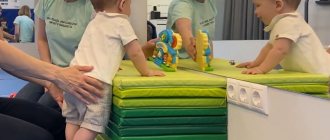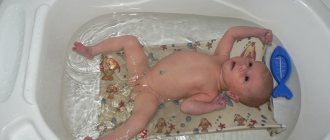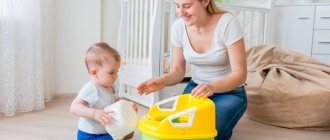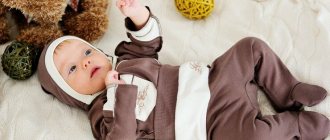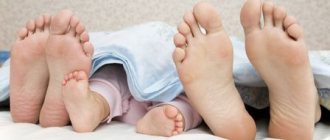Stages of formation of the musculoskeletal system
Every newborn has beautiful, plump feet. They don't look like the legs of an adult. A flat foot in a baby is completely normal, since the arch of the foot has not yet developed. It begins to build only with gradual load; at first, the skeleton of the foot consists of soft cartilage. When a baby learns to walk, the foot transforms three-dimensionally from the inside: the heel rotates and the arch rises.
The formation of muscles and bones occurs gradually, imperceptible to daily external observation. They are prepared to take on future loads. The brain functions that control movement develop in parallel. During the first year of life, the baby acquires the necessary skills and becomes ready to walk, run and jump.
Ability to lift the upper body
At about four to five months, the baby begins to sit up, lying on his stomach and leaning on his hands in front of him. If he does this confidently, then he has successfully completed the first stage and is prepared to roll over, sit, crawl and walk in the future.
Ability to crawl
The next period, around the seventh month, is very innovative. The baby may begin to lean on his hands and push his knees under him. Gradually he moves forward and backward and finally begins to crawl.
The baby begins to crawl
Active crawling
Improving his skills, sometimes the baby crawls incredibly fast. Crawling is a very important stage of development; the child uses the whole body and learns to overcome obstacles.
Important! When the baby gets somewhere, it is better not to help him if this does not threaten his safety.
Trying to get to my feet
After 7 months of age, there comes a time when the child begins to make attempts to stand on his legs. He rests on the walls of the crib and pieces of furniture. At the ninth month, children begin to walk around furniture, or holding hands with adults.
First confident steps
Gradually, the child becomes brave and begins to confidently shift his weight from one foot to another. One day he will let go of the support and take his first independent steps.
Important! The baby will fall a lot, so you should remove all dangerous objects.
During this period, many adults make the mistake of catching and guiding the child. It is better to give him the opportunity to independently realize his strength. At about one and a half years, the baby should walk relatively well. He begins to discover new dimensions for himself.
Safety in the apartment: is the house ready for the baby’s first steps?
While making sure that your child walks comfortably and comfortably, it is important not to forget about his basic safety: as soon as the baby gets on his feet, he literally moves to a new level... and begins to reach those shelves and objects that he had previously talked about. could only dream
This means that in order for the baby’s first steps to be a reason for joy, and not for permanent stress, you need to prepare for these very steps.
So, take a critical look at the apartment and...
- move all fragile, valuable and heavy objects located less than 1.2 m from the floor;
- remove the tablecloths: they are very easily pulled off the table along with all the contents;
- hide all household chemicals in an inaccessible place: washing powders, stain removers and bleaches no longer have a place in an easy-to-open drawer under the bathroom;
- block electrical outlets with special plugs;
- Get into the habit of putting all sharp, piercing, cutting objects in a place where the baby cannot reach them - even if he tries very hard.
In addition to potentially dangerous objects that can bruise, prick or burn the baby, at the “pioneer” stage, a myriad of corners and furniture handles are found in the apartment, located exactly at the baby’s eye level. Fortunately, modern industry offers a whole range of devices that can literally smooth out rough edges. Corners for tables, special covers for pens, plugs for drawers, door and window stops, staircase blockers are available today in any more or less large children's store. And yet, do not delude yourself: straw, which, according to popular wisdom, would not hurt to lay in the right place, has not been invented by modern manufacturers. The moment a child takes his first step, he takes a step towards his independence. And along this path there will certainly be sharp corners and treacherous steps, tears, abrasions and bumps. The baby will fall a thousand more times - and rise a thousand and one times, until he finally really stands firmly on his feet.
Early placement of the child on his feet
The most important principle is not to push the child. He needs time. Healthy development occurs naturally. Each baby is unique and knows best when it is time to stand on their own.
What could a rash cause in a baby?
Of course, you can help him, but within reasonable limits. Walking is only the culmination of the whole process and precedes many skills that a little person must learn before standing. It is not so important to teach a child to walk as it is to endure not helping him.
At 2, 3, 4, 5, 6 months
In some cases, it is worth knowing when you can start putting your child on his feet, and what kind of support the baby needs:
- At 2-3 months, the formation and strengthening of the muscular frame around the spine is not yet complete, and the legs are also not ready for loads. 3-month-old babies can be placed on their feet solely to identify reflexes. This is done by the pediatrician as needed;
Important! At the age of 3 months, a child should not be allowed to lean on his legs. If it is in an upright position, then it is necessary to support the full weight of the child with the hands of an adult.
- 4 months. Some experts advise strengthening the child's step reflex, which is formed if you periodically lightly lean the baby on his legs, still holding the main weight in his hands. It is believed that in this way he will learn to walk faster, without even trying to crawl. However, these recommendations are questionable and not supported by serious practical results;
- 5-6 months. At this stage, some infants try to stand up on their own, holding onto support. But their legs are still not ready to support the weight of the baby; the child should not be allowed to stand on his feet for a long time. If he doesn’t give up trying, it’s better to hold him under his arms, not allowing him to fully rely on his own legs.
The baby stands up, holding onto a support
Formation of a child's foot - an orthopedist answers questions
Number of views: 86,898
Questions regarding the proper development of a child’s foot are answered by an orthopedic traumatologist of the highest category of orthopedic, candidate of medical sciences Sergei Serdyuchenko.
Orthopedic provides a full range of consultative and diagnostic services in the field of traumatology and orthopedics at a high professional level. Here you can undergo an examination by a pediatric orthopedist, an adult orthopedic traumatologist, order computer diagnostics of the foot, ultrasound, and the production of individual orthopedic insoles. The center also has specially equipped rooms for applying immobilizing bandages and intra-articular administration of medications.
Great news for members of the MomExpert club - 20% DISCOUNT for club card holders.
Click here to find out how to get your discount:
Get a discount!
Question: Until what age does a child’s foot develop? What should parents pay attention to? What preventive measures are needed? What are the rules for choosing winter/demi-season/summer shoes for kids? Is there a difference? Is it necessary to buy shoes marked “ORTO” for your baby?
Answer: The main formation of the foot occurs until approximately 12 years of age. This is the period when you can try to actively influence the development of the foot. The child should be examined by an orthopedist at least once a year and adjustments to the regimen should be made if necessary. The word “orthopedic” does not guarantee that these will be good quality boots. Shoes should always be chosen according to size, not for height.
Question: The child is two years old. When he walks in shoes, it is noticeable that one leg is a little clubbed. Everything seems fine at home. I don't notice anything like that. Should we sound the alarm? We did an ultrasound of the hip joints at half a year. Everything was fine.
Answer: The child needs to be examined by an orthopedist. There is a diagnosis of congenital clubfoot - this is a pathology of the foot: it requires serious orthopedic treatment and plaster casting, in your case this is clearly not it. What mothers call clubfoot is no such medical term: there is no Russian-language definition. There is an excessive rotation of the upper thigh in front, in this case the child artificially twists the leg inward. You can’t sit in a W shape, you need herringbone walking exercises and dancing. With growth, such a turn can worsen if sitting incorrectly.
Ultrasound of the hip joints cannot give a 100% picture of all variations in the formation of a child’s leg; it assesses the degree of development of the acetabulum. There is also the orientation of the upper thigh; as the child grows, it may not change for the better; nothing may appear right away; then children walk with their toes inward, sitting in a W shape. If something bothers you, it is better to see an orthopedist and look at the baby’s legs.
Question: My daughter is now 1 year and 2 months old. I myself have flat feet and hip dysplasia. At 4 months old, the child had an ultrasound of the hip joints and was told that everything was normal, there were ossification nuclei. She began to walk without assistance at 10 months. The question is: Does she need shoes at home or can she wear socks?
Answer: At home, shoes are desirable. You don’t have to wear it 24 hours a day, you can take it off and walk barefoot, on carpets, orthopedic rugs, etc. and don’t forget about muscle training.
Question: The child is 1.4. She has been walking independently since she was 11 months old. One leg bends inward. Especially noticeable in shoes on the street. At home, when without shoes, he walks on his toes, more often when he runs. When he is not in a hurry, he places his foot correctly, is this normal? Do I need to wear shoes at home? At what age can you walk on orthopedic mats and for how long and is it even necessary?
Answer: The child needs to be examined; sometimes it is necessary to conduct additional studies regarding the hip joints.
Question: Interested in when you should buy your child shoes for going outside (boots, boots)? When did you just switch to a stroller? Or when he starts walking on his own and walks next to the stroller, and before that, booties will suffice? Please tell me what the nose should be like in the first shoe? How to choose a size? And what is the maximum size reserve you can take in baby shoes? At what approximate speed does the leg grow in children of the first and second year?
Answer: Shoes are needed from the moment the child begins to stand up on his own. It is worth taking shoes by size, the margin is 5-7 mm, which toe of the shoe is not very important, pay attention to the heel, instep and sole.
Question: At 3 months old, the child was diagnosed with hip dysplasia. The folds were not symmetrical. They prescribed massage and paraffin. We completed the course. Further residual dysplasia at 1 year. We are now 2 years old. What are our actions? Should I take another photo and ultrasound? How can you see dysplasia yourself and what can be the risk of untreated dysplasia?
Answer: Dysplasia must be observed. As a rule, residual dysplasia does not threaten anything; everything will develop with growth. But in order to understand in which direction the process is going dynamically, you need to take pictures and compare them with earlier ones.
Question: Is it normal for a baby not to kneel at 6 months of age? Thank you in advance!
Answer: What a child begins to do is largely individual. I think it’s not scary that he doesn’t kneel.
Question: How do you know when your child is ready to sit up and learn to walk?
Answer: Do not put your child in a walker yourself. Your task is to work with his muscular system. When the muscles gain sufficient strength, the child will sit, crawl and walk.
Question: Please tell me, if at the three-month appointment with the orthopedist there were no questions, when is the next appointment. And is there any schedule for visiting this specialist?
Answer: During the first year of life it is worth showing up 2-3 times. If you were at 3 months, the next examination is at 6 months, and then at the discretion of the orthopedist.
Question: The child is almost 8 months old, sits unsteadily, and tries to crawl. He sits down over his hip, leaving one leg bent behind him and aligning the other, adjusting it all the time. Is such a landing scary? Another concern is the position of the feet: the toes are constantly stretched out and the feet are turned out, looking at each other (like a ballerina), and when in a vertical position, touching the plane, the feet are also on the toes, and the toes on one foot are turned. I saw a neurologist and an orthopedist two months ago, there were no questions. But I’m worried about what to do under such circumstances, should I worry?
Answer: Judging by the way you describe the situation, there is still hypertonicity and muscle imbalance. You need to work with a massage therapist to bring the muscles back to normal. Also sign up for a swimming pool with your child, this is very useful for his development.
Question: My daughter had a congenital dislocation of one hip joint and dysplasia of the second! We wore the Orlette splint for up to 9 months, then for another 3 months we wore a splint with rings! In a year everything was removed, the orthopedist said everything was fine. Now my daughter is 8 years old and sometimes complains of pain in her joints. What do we need to do, are there any residual problems?
Answer: Congenital dislocation is a fairly serious condition. As the child grows, it is necessary to monitor and monitor how the joints develop. First, you should see an orthopedist.
Question: My 2.5-year-old daughter began to roll her foot inward. We wear orthopedic shoes. What else can you do?
Answer: You need to look at it individually; if the valgus is severe, shoes may not be enough, then you need to raise the question of orthotics (orthopedic insoles). And train the inner calf muscle group.
Question: Please tell me, the child is already 1.10 and his right leg is clubbed. Is this possible and how can I fix it? (maybe massage or procedures) my husband is also clubbing, apparently it was inherited.
Answer: First, the child must be examined by an orthopedist and decide on the need for additional diagnostics. In addition, when he grows up, give him lessons in choreography, dancing, etc. to form the correct walking stereotype.
Question: A baby (7 months old) twists his leg when walking. Places it on the outside of the foot. We put on shoes when we want to stomp. Doesn't wear on a rug. He stomps around the house for maybe 5 minutes. Then a break. Then stomp again. Maybe the shoes need to be worn longer? Or is that enough?
Answer: There may be hypertonicity of the internal muscle group. A consultation with a neurologist, massage, and exercise therapy for the feet are required.
Question: at what age can a child sleep on a pillow, of course not a huge one, but a tiny one?
Answer: After a year you can use it.
Question: During childbirth, the child had a fractured collarbone. The orthopedist looked at it for a month and said it was normal. Is it worth observing and being interested in every orthopedic appointment?
Answer: A child’s collarbone grows together in a week without consequences, forget it.
Question: Your opinion on the first shoes for babies as soon as they stand on their feet and take steps along the support: it is necessary/not necessary. There are a lot of opinions. Also about ortho mats? If you need shoes, what brands? The choice now is from Nemansky to minimen)
Answer: In my opinion, in apartment conditions it is necessary. Ortho mats are needed, they make the muscles work. From the preventive: Whoopi, Miniman, Toto, Bartek, they are about the same class. But each manufacturer may have worse and better models. So you need to look at the specific manufacturer.
Question: The child is three months old. Is it possible to walk with my daughter for a short time in an ergo backpack? Or is it still impossible?
Answer: You can carry it in an ergo backpack for a short time: several times a day, up to 2-3 hours a day. Shouldn't be worn all day. Of all the carriers, a sling is the best.
Question: Walkers and jumpers - can a child wear them and for how long, from what age?
Answer: Jumpers and walkers are not recommended at all. Jumpers put stress on the spine, while walkers put stress on the feet and back. The child has not yet started doing something himself, which means his muscular system is not yet ready, there is no need to force things. If the baby is already walking and pushing a wheelbarrow or stroller in front of him, this is possible.
Question: The child is 1.10, has x-shaped legs. Can this be fixed? What shoes are better to wear, what toys are preferable (bicycle, balance bike, etc.)?
Answer: There is no need to correct anything yet; the final shape of the legs will be formed later. See orthopedists and do general strengthening exercises. Let him ride.
Question: Does the hardness and surface of an Ortho mat matter? What advice would you give your baby for his first steps? Are they useful for a 7-month-old baby who doesn’t walk yet, but just stands at a support?
Answer: Ortho mats with different surfaces, needles, pebbles, etc. then different muscle groups are worked out.
Massage mats are separate modules that are connected to each other like a puzzle. Due to the different texture and hardness of the surface, during classes on ORTO PUZZLE mats, all the necessary receptors in the child’s foot are stimulated, contributing to the formation of its physiological arches.
Question: Is it possible to use ortho mats of different hardness for babies under one year old? Is there any benefit/harm if the baby just stands and doesn’t walk?
Answer: Accustom it gradually. If you just started walking on shoes, just roll them with a jagged ball on the sole. When he grows up, you will move to the mat.
Question: The child is 11 years old. One leg is slightly clubbed when walking. At birth, no pathologies were detected; during routine examinations, the orthopedist did not find any abnormalities. In the “heels together, toes apart” position, the toes are spread almost 180 degrees. Is it possible to somehow correct it with exercises and wearing orthopedic shoes? Not only I notice, but also those around me.
Answer: This is most likely a gait stereotype - a habit. Of course, you need an orthopedist to take a look, and if there are no problems, you need to teach the child to walk, change the gait pattern: choreography, dancing.
Question: What is the probability of a child having dysplasia if the mother had dysplasia in childhood (plaster was applied). And in general, is there a hereditary connection with dysplasia? (The orthopedist at the first visit at 1 month did not reveal any abnormalities in the child, but I did not know that I had dysplasia). Is a repeat examination necessary taking this fact into account and should an ultrasound be done now?
Answer: Heredity plays an important role in dysplasia, but the presence of dysplasia in the mother in childhood does not necessarily entail the development of dysplasia in the child. The child should be observed, and if questions arise, immediately contact an orthopedist. The child should be examined by an orthopedist at least once a year, if there are questions - once every six months. At 3 months, an ultrasound must be done, even though visually everything is fine.
Question: How long does surgery take for polydectyly of the lower extremities?
Answer: Up to 2 hours, it all depends on the form of the pathology and the scope of the operation.
Question: We are 9 months old, trying to stand on our feet, but mostly on our toes, not on our entire foot. Do I need to wear shoes now and what kind? Or only when the child starts? What should be present?
Answer: First of all, you need to be examined by a neurologist; most often the problem is hypertonicity of the posterior muscle group. Need to work with massage therapists. If the baby continues to walk on his toes, you need to add a higher heel to the usual criteria for proper shoes to firmly fix the ankle so that the habit of walking this way does not form.
Question: Should a child under three months have professional treatment? massage (relaxing and toning)?
Answer: Massage is recommended from 2 months, according to older indications. The mother has her own set of exercises, and the massage therapist works with the muscles; 2-3 courses of massage per year, even for a healthy child, allow the baby to develop better.
Question: Please tell me, when the child had an ultrasound of the hip joint at two and a half months, the ossification nuclei were not formed. Do I need to do a repeat ultrasound? If yes, then when? And in general it’s not very scary, is it?
An ultrasound is needed at about 5-6 months of age. At 2.5 months - if only the ossification nuclei, then this may be a variant of the norm. The assessment is carried out in a complex manner: not only the ossification nuclei, but also the alpha and beta angles and other criteria. Based on the combination of several parameters, a conclusion is made about the maturity of the joints. You are now recommended to use wide swaddling, work with a massage therapist, exercises: bicycle (circular movements in the hip joints)
Question: Hello. A child 1.7 on one leg has one toe “hiding” behind the ones next to it. Why is this and is it dangerous? And he also has a clubfoot on his right leg. Should we sound the alarm? (I myself have also had the right leg since childhood)
Answer: If it does not interfere with the child’s wearing of shoes or does not rub them, there is no need to do anything. Such congenital features of the foot occur. With age, everything is modeled. Regarding clubfoot, you should consult an orthopedist; you need to understand this individually: there are different variants of clubfoot and different correction methods.
There is a diagnosis of congenital clubfoot - this is a pathology of the foot: it requires serious orthopedic treatment and plaster casting, but in your case this is clearly not the case. What mothers call clubfoot is no such medical term: there is no Russian-language definition. There is an excessive rotation of the upper thigh in front, in this case the child artificially twists the leg inward.
Question: How to correct x-shaped legs in a girl? Return 2.3 years.
Answer: Just watch for now. For a child of this age, this is the norm. The final shape of the legs is formed by 7-8 years. Monitor your child's weight; excess weight has a very bad effect on the shape of your legs in the future. General physical training is recommended: swimming, cycling.
Question: What is your opinion about orthopedic shoes: treatment or marketing?
Answer: If a child has a specific problem, a severe foot deformity, then it is impossible to correct the situation without orthopedic shoes. If the child is healthy and the foot is formed correctly, you can select preventive shoes. If the child is not specifically trained and the foot muscles are not trained, then there is little chance that a healthy foot will form without the right shoes.
Question: The child has mild valgus. Is it possible to jump on a trampoline?
Answer: Yes! Jump for fun.
Question: Both parents have flat feet. My father's is small, my mother's is more serious. Is it hereditary? How to avoid it? Is it true that simple flat feet cause scoliosis?
Answer: Heredity is one of the risk factors for flat feet; there is a hereditary predisposition. Avoid is not quite the right word. It is necessary to create conditions for the normal development of the foot: exercises, shoes, and, if necessary, an insole correctly selected by an orthopedic doctor. Training your muscles is even more important than just shoes. Not all children with scoliosis have problems with their feet and vice versa, there is no direct correlation, sometimes it happens at the same time, but not always
Question: When should you put on your first shoes? What are the requirements for it?
Answer: After the child begins to stand on his feet. Requirements for the first shoe: a tight heel, an instep support, a closed midsection and a flexible sole. A closed nose, by the way, is not a mandatory criterion.
Question: Is ultrasound of the hip joints a month required?
Answer: Per month, according to the orthopedist: movement restrictions, asymmetry. At 3 and 6 months, it is recommended to do an ultrasound for all children, since it is not always possible to determine all types of pathology with your hands.
Question: Wearing orthopedic shoes at home for the purpose of prevention. Your opinion?
Answer: It is advisable to wear proper shoes. There is NO need to chase the word orthopedic; the manufacturer can register the shoes in any way they want. The right shoes: a tight heel, arch support, a closed midsection and a flexible sole. Orthopedic insoles - according to indications. If there are carpets - less relevant. Part of the time in shoes, part of the time barefoot. It’s good to train the foot and develop muscles: walk on your toes, on your heels, on the outer edge, pick up small objects with your toes, lay a towel and rake with your toes. Massage mats have proven themselves well.
Question: Is it likely that valgus positioning of the legs (no flat feet) will be corrected after 6 years? There is no hereditary factor.
Answer: There is a possibility. But you need to put in a lot of effort: the main thing is muscle training, insoles according to indications depending on the motor activity and the child’s regime. If a child plays sports, insoles are a must.
Question: The baby is 1.5 months old. The birth was natural, without complications, the fetus was positioned in the head. We went to see an orthopedist. According to the preliminary result of the examination, hip dysplasia was indicated, but naturally an ultrasound was prescribed at 3 months. Is it necessary to wait 3 months, or can an ultrasound be done a little earlier, so that if something is wrong, then treatment can be started earlier? While we are doing a light massage of the legs, “frog”, “bicycle”, “figure eight” on the foot.
Answer: If the orthopedist did not immediately identify gross pathology, then you can wait up to 3 months, since up to 3 months the joint may be immature, this is normal. 3 months is the limit, after this age the joint must mature. At this age you need to do an ultrasound and determine
Question: What are the restrictions on sports for valgus placement?
Answer: Valgus: running, jumping, contact sports with caution. If the child likes it and nothing bothers him, he can be placed on insoles and he can study. It is important to select the correct load and combine it with orthopedic components: the right sports shoes; for an athlete, it is better to have individual insoles made specifically for him, taking into account the peculiarities of the formation of the foot.
Question: I often hear the opinion that a child who has learned to walk should wear shoes at home to properly form the arch of the foot. Is it so? And what kind of shoes can be considered “correct”?
Answer: It is advisable to wear shoes at home, and the correct ones. Don’t bother with the word orthopedic; the manufacturer can register the shoes any way they want. The right shoes: a tight heel, arch support, a closed midsection and a flexible sole. Orthopedic insoles - according to indications. If there are carpets - less relevant. Part of the time in shoes, part of the time barefoot. It’s good to train the foot and develop muscles: walk on your toes, on your heels, on the outer edge, pick up small objects with your toes, lay a towel and rake with your toes. Massage mats have proven themselves well.
Question: My baby is 4 months old and the folds on his legs at the back are not symmetrical. At 3 months we went to the orthopedist and had an ultrasound, everything was fine, they were the same. Could this be due to the fact that he is chubby?
Answer: If everything is fine on ultrasound and clinically everything is normal when examined by an orthopedist, then everything is fine. Folds are not the most important diagnostic sign, it happens sometimes, it has nothing to do with weight, it’s just individual characteristics
Question: Is it necessary to show the child to an orthopedist at 1 year of age (as a medical examination) if there were no pathologies at 1 month?
Answer: Definitely. At least once a year, the child should be examined by an orthopedist-traumatologist; the situation may change with growth
Was this information interesting and useful for you? Please share your opinion!
comments powered by HyperComments
Consequences of getting up early
Crusts on a baby’s head - how to remove them
Adults don't think about how difficult it is to stand on their feet, when balancing uses many muscles in the body and requires fine tuning. The child must master everything on his own, spending a certain amount of time on it:
- Postural control. Describes the involuntary motor and sensory processes that allow the child to maintain position against gravity. It develops throughout early life, from the ability to hold up the head to the ability to walk confidently;
- Ability to support your weight on your feet. When a child lies, his weight is distributed along the entire length of his body. To learn to stand, he must be able to support his full weight on his legs and feet;
- Motor skills are those abilities that use the large muscles of the body and enable you to kick, lift, and walk. They require muscle tone and strength, as well as the ability to perform motor function.
Important! Early standing on legs provokes an inadequate load on the spine for this age, and also leads to problems with the hip joint, which is still in the development stage, up to dislocation of the femoral head.
In addition to the hip joint, early standing can cause pathologies in the development of the knee joints, feet, and poor posture.
Stages of skill development
The ability to sit or walk looks the same for almost all children. And only crawling is an excellent “space” for expressing individual style: all children, if you carefully observe, crawl in different ways, in the way that is comfortable for them. The skill develops in stages, and at each stage this individual style will be clearly visible.
The skill is formed according to its own laws, regardless of the baby’s crawling style. Let's look at the main stages of acquiring a skill.
On the stomach
Babies usually start crawling on their tummy first. This method does not require much physical exertion from the baby; it uses the abdominal and back muscles.
The prone position is the easiest way to learn a new method, since the baby feels safe in this position. Nothing threatens his balance and position in space. In addition, you can always relax and lie in your usual position - on your tummy, if you get tired of moving forward.
The start date for this stage is the earliest. On average, babies master moving on their belly at 5-6 months. At the initial stage, the child needs fairly strong arm muscles, because after turning onto their tummy, they need to learn to push off the plane with their hands.
On the stomach with the participation of the legs
About a month after mastering moving on his stomach, the child begins to understand that in order to achieve the goal in front of him, he needs to move in its direction, because moving backwards or sideways does not bring the treasured toy one iota closer. Then most children begin to use their legs - they push off with them. The result is a forward movement of the body, but the baby is still on his stomach.
As the ability to push off with the legs simultaneously or alternately improves, a fully-fledged skill of crawling forward on the stomach is formed, in addition, the child begins to understand that bent legs lift him above the plane, and he learns to stand on all fours. The basic (very conditional) time frame for the beginning of the stage is 6-8 months.
On knees
As soon as the baby learns to transfer his body weight to his legs and arms, he will begin to get on all fours and sway. At the same time, he will fall and hurt his chin and nose, and therefore, already at this stage, parents should make sure that there is a place in the house for crawling - with a soft floor covering that will soften failures.
It is impossible to force a child to crawl on all fours. The instinct of self-preservation clearly tells the little one that if there is no sense of balance, there is no need to move anywhere. Therefore, the baby will swing on all fours as long as necessary to strengthen the muscles of the limbs, because they now bear the main load. On average, the period starts from 7-9 months. Its duration is purely individual.
On all fours with rearrangement
This is the final stage at which the baby, who has learned to estimate his weight and balance on four points of support, begins to rearrange his limbs, while simultaneously distributing the weight to the other three or two limbs. First, the kids rearrange their arms, pulling their legs behind them, then they master the synchronous rearrangement of their arms and legs.
From this moment on, the child resembles the notorious “electric broom”, which manages to be present here, there and in the next room almost simultaneously. This period will require parents to take special care of the baby’s safety. He is already getting to previously forbidden drawers, shelves, the kitchen, the stove and the trash can. Be carefull.
Baby's readiness to stand on his feet
On average, parents should focus on the child’s age and not try to help him get on his feet before the ninth month of life. But not all children develop at the same speed; some are ready to get up a little earlier, others a little later.
Signs of readiness
Why does bloody diarrhea occur in a child under one year old?
When determining signs of readiness, the following factors must be considered:
- Genetic. When one of the parents got to his feet too early or, conversely, too late, one should expect the same from the baby. In addition, increased baby weight also slightly slows down the baby's willingness to stand;
- Presence of common diseases. Congenital or acquired pathologies, viral infectious diseases always affect the development of the child. Such kids get up later;
- Cyclicity of physical and mental development. In the development of a child, changes occur in leaps and bounds, slowly accumulating. When the baby makes progress in pronouncing the first words, is captivated by toys, that is, engaged in intellectual activity, he may give up trying to get up for a while and generally moves less. Then, on the contrary, a period of increased physical activity begins;
- Motivation. It lies in the baby’s desire to stand on his own legs. To do this, you can interest him by placing the toy out of reach so that the baby will need to make some additional movements to get it.
Important! For some diseases (for example, juvenile arthritis), parents should not decide to have their child diagnosed on their own without consulting a specialist.
Difference for girls and boys
There is no clear opinion here. Most experts say that there is no difference, it all depends on the physical condition of the baby. Others advise placing a girl a little later than a boy, on average by 1 month.
The age of the child standing on his feet
If parents notice the readiness, and most importantly, the great desire of the baby to stand up, then they often think: is it too early, at what months does a healthy child stand on his feet without the threat of harming his proper development, and when is the time to help him?
There is no need to suppress the baby’s activity and constantly put him down or sit him down when he tries to get up. It will be enough for the parents themselves to get rid of attempts to install it. He still won't be able to stay on his feet for long.
When the child has reached about 8 months, sometimes earlier, and shows a frequent desire to stand, the parents’ task is to support him with his armpits, trying to avoid prolonged stress on the child’s legs and spine.
Creating conditions for walking
To master one of the difficult, but very interesting skills for a little person - walking, parents can use the following approaches:
- Do not lead your child by the hand. This action significantly reduces the baby’s need for independent movement and, accordingly, delays the development of independent walking. On the street, the child can be supported in the pelvic area - protecting against improper falls. At home, the child should be given complete freedom to move along the support, taking tentative first steps, stimulating with favorite things or toys.
- Do not use devices that cause an artificial vertical position of the body - walkers or jumpers.
- Reduce the amount of time the baby spends in your arms. Provide him with more games on the floor or in the playpen.
- Provide the ability to move independently in space. It is very important here to secure the room, make it spacious and free, so that the baby does not have any obstacles in moving.
- Practice gymnastics for a child who can stand against a support. If the child has already mastered this skill, you can teach him to sit down, pick up toys from the floor and get up again.
- Insure your child less . It is normal for a child to fall on his buttocks when trying to take his first steps or stand up. Parents need to be prepared to insure their child, but try to provide conditions in which such a fall will not cause pain. For example, a place where a child can stand, leaning on something, can be covered with a soft covering made of EVA material. This way the child will be able to walk barefoot, since the floor becomes warm, and an accidental fall will not be traumatic.
- Buy a wheelchair or trolley walker. Unlike advertised walkers, which are not recommended by pediatricians, these walkers do not support the child’s body and do not disturb his balance while walking. Such a thing will serve as a toy and support, pushing which the child can take his first steps without fear of falling.
Reference! According to the recommendations of leading pediatricians, the baby's first steps around the house should not be accompanied by any shoes. It is best to ensure safe movement indoors and allow the baby to move around barefoot.
Doctor Komarovsky's opinion
An authoritative children's doctor, Komarovsky, is categorically against any exact timing in determining the child's ability to stand. He believes that each child develops individually, copying the behavior of adults; the main thing is not to interfere with him or try to forcefully influence the development process.
Doctor Komarovsky
In his opinion, if a child does not show a desire to sit down, stand up or crawl, any attempts to put him in pillows or stand him up will bring nothing but harm. If the child tries to do this on his own, then he needs to be actively encouraged.
When a child begins to stand prematurely
There are cases when some children make their first attempts to rise much earlier than generally accepted norms. This isn't always a bad thing. If your baby has learned to sit earlier than his peers, it is quite expected that he will begin to get up earlier. If your child is already more than six months old, then you should not interfere with the baby’s endeavors. You must understand that the baby will still try to get up, and you cannot control him 24 hours a day. But getting up on your feet before reaching six months of age is not permissible; such actions will disrupt the proper development of the musculoskeletal system and cause irreparable harm to your health. That is why it is very important to encourage the child to crawl, to show that he can move around the apartment to any corner, and that there is no need to stand upright yet.
Helping a child stand on his feet
Some parents strive to put their child in a walker. Walkers are potentially dangerous. They do not teach walking, but they do expose children to the danger of falling over. Accidents have been documented, for this reason pediatricians in many countries are calling for a ban on the production and trade of walkers.
Child in a walker
Important! Walkers are the enemy of correct posture and correct development of legs and feet. In fact, they teach the child to walk on his toes and delay the acquisition of a sense of balance.
Without getting ahead of the curve, parents can help children strengthen their muscles and prepare them to successfully learn new skills. Ways that should help with this:
- Exercises for the baby, with massage of the feet and flexion/extension of the legs;
- Performing a general body massage under the guidance of a specialist;
- Exercises in the pool, a combination of swimming with various water exercises, have a beneficial effect on psychological and physical development;
- Encouraging baby to crawl. For example, put him on his tummy and attract attention with a toy. When he tries to crawl, place your palms on his feet so that the baby can push off.
Encouraging baby to crawl
The correct development of babies depends on the patience of parents and the environment. Let the child do what comes naturally to him. If you force him to be active for which he is not yet ready, the baby will face problems for life. It is useful for parents to be guided by the main principle “It is better to help your child without helping him at all.”
How to teach a child to crawl: action plan
To teach a child to crawl, first of all, you need to make the baby want to explore some object, you need to make sure that he has such an opportunity. Surround your baby with a variety of interesting toys and objects (for example, a saucepan lid is also a very entertaining thing), and also give him some freedom of movement outside the crib or playpen. The most effective way to motivate a child is not to show him how to move, but to offer him interesting stimuli.
Children begin to crawl on average at 6-7 months, but you should prepare for this important process in advance. Below is a sample “action plan” for teaching a child to crawl:
- If at 3 months the baby has not yet learned to hold his head up on his own, you should often put him on his tummy and put interesting objects in front of him, bring the baby to various things in the apartment so that he looks at them. A course of health massage to simulate motor development (especially in the case of muscle hyper- or hypotonicity) and strengthen the muscular system will not hurt. If necessary, an osteopathic doctor will remove muscle tension that impedes the baby’s freedom of movement. In addition, at one month, three months and six months you should visit a neurologist who will assess the state of the child’s nervous system.
- At 4 months, offer your baby more objects that are easy to grasp; At this age, the baby is interested in his legs - try to teach him to grab his legs and even reach them to his mouth - little ones usually like this activity.
- At 5 months the child begins to move himself in space. First, try to teach your baby to turn on his side for an interesting toy, use the sound of a rattle so that the baby begins to move in the right direction. To help the child roll over onto his side, you can, from a position on his back, move his knee to his side so that he can complete the turn of the body himself.
- At 6 months, continue to practice spins and various turns. If the baby has not yet sat down on his own (normally from 6 to 8 months), help him do this, but do not pull him forward by the arms, but over the side, moving his hands.
- At 6-7 months, babies begin to crawl in some way: on all fours, on their bellies, on their butts (especially if you have parquet or linoleum, then moving around while sitting on your butts is much more fun :)), etc. Before starting to crawl in the classical sense (on all fours), the baby trains for several weeks to stand on all fours, swings his whole body funny, etc. To encourage crawling, lure a baby lying on his stomach with toys and household items that children like so much. Play with your child various finger games (pallets, magpie-crow), stomps, read rhythmic poems and listen to children's songs with your child that are good for moving. You can make a tunnel or obstacle so that the baby begins to crawl on all fours or on his belly. Children love to crawl over mom or dad, and also crawl from mom to dad and back, so the presence of a significant adult is in itself an excellent incentive for movement.
If your baby crawled at 6-7 months, then eight months is the time for selfless crawling and attempts to stand up with support. If at this age a child avoids active movements and tries to achieve what he wants with the help of screaming, this can be both a manifestation of character and a consequence of motor difficulties. Continue teaching your baby to reach for objects on his own. A repeat course of wellness massage will not be superfluous.
At 9 months, almost all children show a desire to take a vertical position (stand on their legs); there is no need to forcefully lift the child, but you can help if the baby is trying to stand up. If the baby is still just crawling, this is also normal.
It is important to give him more space to move around at this age, and give him interesting objects and things that he wants to grab.
Almost all children have been able to stand on their own for about a year, but everyone takes their first steps at their own time, so there is no need to rush the baby, everything will come in due time.
How babies learn to stand
It is important to carefully monitor the behavior of the little one: if he tries to get up, you need to help him. Getting up is a process that has different stages. Even a newborn baby actively moves his legs, constantly pulling them up. At 2 months of age, the baby reflexively kicks his legs.
To build leg strength, you can lower your child onto soft surfaces. At approximately 3-6 months, the baby's reflexes are replaced by attempts to withstand some weight. They even begin to jump with pleasure when their feet touch a hard surface.
From 6 to 10 months, the baby begins to pull himself up, using furniture for support. At first, this will be done with great effort - the baby puffs and grunts, squeezing the sofa upholstery in order to get up. At this stage, you need to support your child as much as possible by clearing the space of sharp objects and placing pillows nearby to soften the blow of a possible fall.
In general, falling is a very important process for young children as they gradually master the art of standing and, eventually, walking. First, they learn to stretch their arms forward for balance and, if necessary, to fall gently. By 9 months, it becomes easier for babies to stand on their feet, but they still cannot lower themselves smoothly and fall, hitting themselves a little.
From 10 to 12 months, children learn to bend their knees and even sit down after standing. However, for them it is much more difficult than it seems to us adults.
By the time your child is one year old, he can stand on his feet and sit on the floor with more confidence. Practice walking for at least 15-30 minutes every day, and use pillows as barriers.
Baby's first steps
Of course, there are ways to stimulate the baby’s desire to stand up:
- Place bright toys in close proximity to the young explorer. Let them motivate him to crawl, stand, or pull himself up.
- If your son is standing, but it seems to you that he is still unsure and afraid, help him. Place a coffee table or other sturdy furniture nearby without sharp corners or risk of tipping over. Your little guy uses different pieces of furniture for maneuvering and stability on his feet.
- A crib is a great place to learn: remove anything that could cause your child to trip over it. If possible, move the mattress to a lower position.
- Pediatricians do not recommend using classic walkers at an early age. According to experts, they slow down the motor development of the baby and can cause back problems. The worst thing is when the walker tips over or rolls down the stairs along with the child.
- Look for durable toys or modern walkers with large wheels and a handle that your little one can lean on.
- Do not leave your baby in the playpen for a long time - no more than 30 minutes at a time.
- Indoors and on safe outdoor surfaces, allow your little one to walk barefoot or wear non-slip socks. This will maximize muscle tone in the legs and ankles, and the child will learn balance and coordination faster. In the cool season, choose lightweight shoes with flexible soles. Too high booties and sneakers restrict the baby's movements.
- Motivate him: clap your hands while watching your pet try to walk towards you, sing along and even try to dance with him! But don't force it.
In addition, children who are already “walking” sometimes suddenly return to crawling after an unfortunate fall or illness. Do gymnastics, swimming and massage with your children to strengthen their health and musculoskeletal system.
Exercises to encourage standing up
There are various exercises to strengthen your baby's muscles, which help him maintain an upright position. Using these exercises, it is easy to teach your child to stand without support:
- If the child is not yet standing, then a fitball can help him feel support in his legs. You need to put him with his stomach on a loosely inflated ball, swing him so that his legs touch the hard surface and push off from it. Be sure to gently hold the baby so that he feels the support of his mother’s hands.
- Raise your favorite toy so that the baby can reach it, holding on to a strong support. The baby will begin to strive towards her, looking for an opportunity to rise.
- Adjust the height of the support. When the child confidently learns to stand, leaning on an object at waist level, you need to move the support higher.
- You can try to occupy the hands of a child standing at a support with an interesting toy. Thus, he will lean against the support not with his hands, but with his stomach, and his hands will be occupied.
- In order for the child to learn to sit down from a standing position, a toy is placed on the floor next to the standing baby. When he shows interest in her, you need to help him sit down carefully next to her. This way he will learn not to fall, but to land softly.
- Several toys are placed at different heights. So the baby will try to reach first one, then the other, thereby freeing first one or the other hand.
- While the baby is standing at a low support, you can lay out several toys on the floor. The baby is asked to lift them one by one.
- If you put a small obstacle between the baby’s right or left leg so that they are not at the same level, then he will learn to maintain balance in this position. This develops a sense of balance.
By carrying out such exercises regularly, you can see firsthand how exciting and joyful it is when children begin to stand without support.
Can I use a walker?
To help the child's musculoskeletal system get stronger, you can use a walker, but they are recommended no earlier than 7-8 months. At this age, the baby already supports his back, he will sit in a walker and push off with his legs, and over time he will begin to stand, holding onto the body. Many experts say that walkers do not help to learn to walk faster, but they have a number of other advantages - they allow the baby to be busy for a while, he has the opportunity to actively explore the environment, while being safe. The walker should not be used for a long time, maximum 20-30 minutes. You need to start with 5-10, gradually increasing the time you spend in the walker. At the present stage, there is a claim that walkers do more harm to children than they contribute to their development. They are prohibited abroad due to the fact that many parents sought medical help for injuries that their children received due to the use of walkers; there were disturbances in muscle tone, development of the feet, and hip joints. Most parents want their children to learn to sit, stand, and walk early, but everything has its time. There is no need to rush into this. When the baby is ready, he will sit down, stand up and walk.


